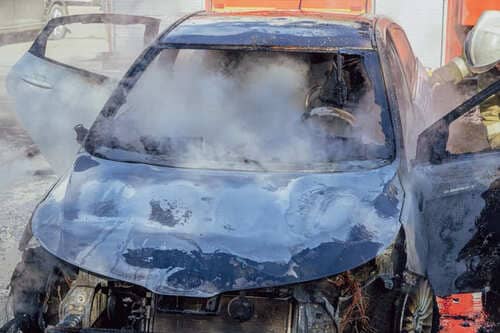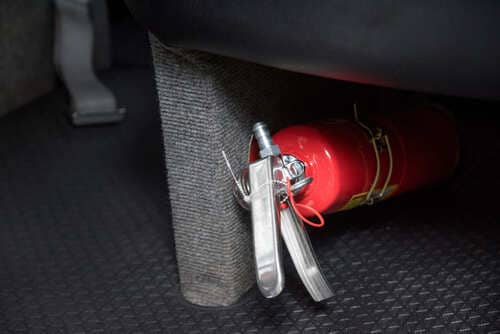From electrical faults to fluid leaks, the causes of vehicle fires are diverse and often unexpected. In this guide, we'll explore essential tips to minimise this risk and the warning signs to look out for, empowering drivers with the knowledge to keep the roads flame-free.
Signs a car will catch fire
There are several signs that may indicate that a car is about to go up in flames. Spotting them early can help to prevent serious road incidents by stopping a fire before it starts.
- Smoke coming from the engine bay, exhaust or car battery
This is perhaps the most visible sign that the car is extremely hot. In some cases, you may see sparks coming from the engine.

- High temperature readings
High readings on the temperature gauge on the dashboard suggest that the engine or car is overheating and the cooling system is struggling to maintain normal temperatures. This increases the risk of a fire.
- Strange burning smells
If you smell burning plastic, rubber or wiring, this could be the result of an electrical fault or overheating components. It is not advised to continue driving before the cause has been determined.
- The smell of fuel
A strong smell of fuel inside the vehicle is often, though not always, a sign of a fuel leak somewhere in the fuel supply system or engine. This means that fuel could potentially ignite outside of the combustion chambers.
- Fuses blow frequently
If one or more fuses keep blowing, it’s usually a symptom of an underlying electrical fault, such as a short circuit. Leaving it untreated could lead to a fire.
- Warning lights or notifications
Don’t ignore the warning lights that flash up on the dashboard. For example, you may see the check engine light or the engine temperature symbol. These lights are normally red or yellow.
What to do if your car is on fire:
- Pull over to a safe place as soon as possible
- Switch off the engine and exit the vehicle and make sure all passengers get out of the car
- Do not attempt to retrieve personal items
- Stand at least 100 feet away from the burning vehicle
- Call the emergency services (999 in the UK) to inform them of the vehicle fire
Only attempt to put the fire out yourself with a vehicle fire extinguisher if you are easily able to locate the source of the fire and do so safely. Make sure to keep your distance from the car.
-
- Weight [kg]: 2
- Housing Colour: red
- Housing Diameter [mm]: 90
- Height [mm]: 290
- Time Domain:
 6 sek
6 sek - Fill Medium: Dry Powder
- Country Specific Design: Poland
- Content [kg]: 1
- Group: ABC
- Condition: New
Details
Article № : GP1Z ABC 1KG/W Fire extinguisher GP1Z ABC 1KG/W
Car parts maker: OGNIOCHRON(5)In stock
£ 15,28incl. 20% VAT -
- Housing Colour: red
- Housing Diameter [mm]: 90
- Height [mm]: 260
- Time Domain:
 6 sek
6 sek - Fill Medium: Dry Powder
- Country Specific Design: Poland
- Content [kg]: 1
- Group: BC
- Weight [kg]: 1.60
- Condition: New
Details
Article № : GP1Z BC 1KG Fire extinguisher GP1Z BC 1KG
Car parts maker: OGNIOCHRON(5)In stock
£ 13,08incl. 20% VAT -
- The set contains: Car first aid kit
- DIN/ISO: DIN 13164-2022
- Width [mm]: 130
- Height [mm]: 55
- Colour:
 red
red - Material: Textile
- Length [mm]:
![230 Length [mm]](https://cdn.pkwteile.de/uploads/icons/product/parameter/pkw/gl/203.png) 230
230 - Packaging: Box
- Compatibility: Universal fit
- Condition: New
Details
Article № : 44293 First aid kit 44293
Car parts maker: WALSER(1)In stock
£ 5,38incl. 20% VAT -
- Fill Medium: Dry Powder
- Housing Colour: red
- Weight [kg]: 1
- Group: GB-1BC
- Condition: Remanufactured
Details
Article № : 98-011 Fire extinguisher 98-011
Car parts maker: VIRAGEIn stock
£ 12,48incl. 20% VAT
What should you do to reduce the risk of your vehicle catching fire?
- Fuel leaks
Whether it’s due to leaky fuel injectors, loose car spark plugs or other faults, fuel leaks should always be taken seriously. After all, petrol and diesel are made for combustion.
- An overheated engine
Engines can overheat due to car engine coolant leaks, insufficient lubrication, software faults, defects or extreme driving conditions. The extreme heat could eventually ignite surrounding fluids or components, particularly if there are spills.

- An overheated catalytic converter
The catalyst is one of the hottest parts of the car, operating at temperatures of around 800°C. If it becomes overloaded with exhaust gases or unignited fuel, it can reach temperatures of over 1000°C. While the converter itself probably won’t combust, the heat could ignite surrounding parts.
- Battery faults
It is not just electric vehicles (EVs) that experience battery fires. In fact, the average likelihood of this happening is greater for standard internal combustion vehicles. The charging cycles of lead acid battery’s can generate a buildup of hydrogen gas near the engine. One small spark, and leaking vapours can quickly turn into a flaming inferno.
The main difference between standard car battery fires and those of EVs is that EV fires are much more intense and difficult to put out and can last for days, even when the battery is fully submerged in water.
- Exposure to hazardous substances
Accidental fires can be caused by simply using flammable items in the vehicle, such as cigarette lighters or aerosol cans.
- Crashes or arson
Dangerous road accidents can spark fires if critical parts such as the engine and battery are damaged badly. A severe crash is likely to generate a lot of heat and cause fluid leaks, creating a further hazard.
Arson is also included as a top cause, although it is unfortunately something out of our control. Someone may set a car on fire for malicious reasons or just for the sake of vandalism.
FAQ
Is engine oil flammable?
According to the flash point, engine oils are not considered flammable liquids. The flash point is the lowest temperature at which a liquid releases ignitable vapours. For flammable fluids, the flash point is below 60°C, whereas motor oil typically has a flash point of 150°C or more. However, it is classified as a combustible liquid.
Is brake fluid flammable?
Again, while it is not considered volatile or flammable like liquids containing alcohol, i.e. hand sanitiser, brake fluid can set on fire when lit to high temperatures.
Can diesel catch fire?
Although diesel is not as flammable as petrol, it can still easily catch fire from a spark. Diesel leaks therefore pose a fire risk.
TOP products on the subject:




































